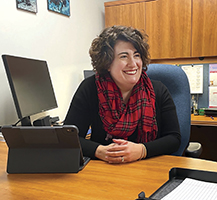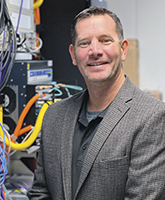 |
| Aleck Johnson |
During the COVID-19 pandemic, when most learning moved online, technology moved to the forefront of education for teachers, staff and administrators. “For us, the pandemic changed these technologies from being ‘nice to have’ to ‘mission critical,’” says Chad Meyer, director of technology for Milwaukee Public Schools.
The shift to online was abrupt and unexpected. The transition among public schools in Minnesota is illustrative of the disruption across the country.
On Sunday, March 15, 2020, Governor Tim Walz announced that all schools in Minnesota were to close by the following Wednesday and were to remain shuttered through March 27 “so staff could use those eight days to prepare for a future shift to distance learning,” says Josh Sumption, director of technology at Southwest West Central Service Cooperative in Marshall, Minn.
“What we didn’t know was that March 17 would be the last day that students would be walking the halls in our schools for the remainder of the 2020 school year,” he adds. “Although districts are typically directed by careful planning, where change is slow and painful, many of our districts packed five years of change into those eight days.”
While some positive developments emerged, Sumption says, “the chaos of it all left much to be desired. We never in our wildest dreams thought the shift to online learning would occur over eight days, resulting in mobile device carts being torn apart, devices slated for disposal being recommissioned and the frantic purchasing of any mobile devices that could be found.”
Educational leaders were left scrambling to find the funding for all the needed technology.
A Major Response
The pandemic has seen a widespread scramble to adopt a variety of technologies, including both synchronous (live) and asynchronous (recorded) video, the integration of learning management systems into daily instruction and curriculum, and the adoption of numerous online tools to assist with instruction and to measure student achievement. While virtually all of these technologies were widely available prior to the pandemic, many schools lagged behind in adopting and adapting them because of financial and human capital challenges. Newer, internet-based technology tools require a number of different components: subscriptions to software, access to devices, access to the internet both at school and at home, and professional development for educators are just the start of a long list.
Fortunately, the federal government has provided resources to support local leaders’ technology needs. These resources largely come from the three stimulus bills (the education components that are typically referred to as Elementary and Secondary School Emergency Relief known as ESSER I, ESSER II and ESSER III), which jointly are providing more than $190 billion in support to schools for a variety of uses, including technology.
In addition, the most recent stimulus bill, passed last March, established a critical new program for education technology called the Emergency Connectivity Fund, or ECF, which provides for up to $7.1 billion in funding for schools to purchase low-cost computing devices and internet connectivity for students to address the homework gap.
These programs, combined with the E-rate program, provide opportunities for schools to modernize their technology infrastructure and
address gaps in equity that are unparalleled in the internet age. However, school districts also must be aware of the challenges these funds present and act appropriately to secure federal monies for meeting district needs.
 |
| Kelly Herr is manager of grants and federal programs in Pennsylvania’s Lebanon School District. PHOTO COURTESY OF KELLY KERR |
Disparate Challenges
These various programs differ based in large part on which federal agency administers the program. The ESSER funds, coming from the U.S. Department of Education and funneled through state departments of education, tend to be more flexible and positioned toward meeting local needs.
Conversely, the ECF program (and the E-rate program), managed by the Federal Communications Commission, tend to be less flexible, with strict rules and requirements.
Fundamentally, these challenges can be characterized along different axes of (a) flexibility; (b) clarity, process and risk; and (c) administration and sustainability.
»Flexibility. The ESSER grants vary from state to state, but generally fall under fairly broad categories that allow districts flexibility to structure their plans to meet specific needs, supporting a range of initiatives that include technology funding.
The ECF and E-rate programs, in contrast, are much more strictly circumscribed in terms of the kinds of hardware and services that can be supported. For example, ECF only supports connectivity and devices (and sometimes only up to certain price points) and only sup-ports connectivity and devices when they are meeting an otherwise unmet need.
ESSER funds also are generally more flexible in terms of the timelines for implementation. Each ESSER program has a multiyear implementation timeframe. ESSER I funds must be obligated by this September. ESSER II funds must be obligated by September 2023, and ESSER III funds must be obligated by September 2024.
The FCC-administered programs work on a funding year basis, meaning applications are for services delivered from July 1 to the following June 30, and the services sought in an application only apply to a specific funding year. This makes it difficult to do longer-term planning and larger projects with ECF and E-rate, given the need to ensure the project is implemented within a relatively short time frame.
»Clarity, Process and Risk. The nature of the process that promulgates the rules and requirements associated with these programs also leads to different results in terms of the application processes and clarity of those processes. E-rate and ECF rules and requirements are promulgated through the legalistic rulemaking process, which means that requirements are not collected in a single, comprehensive lo-cation, but instead are spread across numerous decisions.
For E-rate, which has its origins in the Telecommunications Act of 1996, there are hundreds of these decisions, with requirements evolving over time. Communicating those requirements — and the changes in them — is a huge challenge for these programs. Most recently, with the ECF program, the FCC continued to make clarifications to the rules during and even after the initial application process was completed. These clarifications, which were extremely helpful, unfortunately arrived late for many applicants and were not always received or understood by applicants.
The newer ESSER rules are somewhat more straightforward, but the variations among states can cause its own problems. “Initially, there were federal webinars, and we thought we had a good understanding of how we could spend the [ESSER] money and what we could do,” says Christine Schmitt, director of business services at the Southwest West Central Service Cooperative, an educational service agency with 53 member school districts in Minnesota. “Then the state came along with an interpretation different from our own, and it led to a lot of confusion.”
While the variety of program areas can make understanding all of these rules difficult, the application process generally allows districts to work with states to resolve ambiguities in a way that more centralized programs do not permit.
The differences in how districts apply for funds are also critical to understand and magnify the impact of the clarity concerns. ESSER funds are implemented following a plan process whereby the state has reviewed and approved the district’s plan for that particular program. As long as the district adheres to the plan, the funding should follow. Because the district has developed the plan, the district should have a good understanding of the plan and what will be accomplished.
That doesn’t mean ESSER funding is without challenges, however. Kelly Herr, manager of grants and federal programs with Pennsylvania’s Lebanon School District, says her district filed 14 different plans, most with technology components, with the state in response to the various ESSER programs in 2020 and 2021. “Implementing, monitoring and coordinating among those plans, especially with all the other issues we face this year, has been a real challenge,” she says.
ECF and E-rate applications include numerous self-certifications, with applicants certifying that they understand and will comply with the programs’ requirements. Funding is relatively easy to get approved, but given the combined complexity and lack of clarity that some-times accompanies these programs, retaining funding in the event of an audit can be difficult.
Ultimately, this translates into differences in the level of risk associated with various funding sources. The less clear the rules and requirements are, the greater the risk for participating districts. This risk can be mitigated, of course, by ensuring that district personnel are well-versed in the rules and requirements associated with the various programs — or at least as much as is possible as programs change and evolve quickly.
»Administration and Sustainability Challenges. The greatest challenges coming out of the pandemic with respect to federal technology funding are responsibly administering those funds and addressing the challenges of sustainability.
With respect to technology (as well as other “learning loss” programs), school districts are used to an environment where the con-straining factor traditionally has been funding. The various federal responses to the pandemic have helped, in some measure, to turn that paradigm on its head, according to Chad Meyer, who oversees instructional technology in the 68,000-student Milwaukee Public Schools. “With schools not used to having the funding, they’re also not used to trying to scale up the human infrastructure and district policy processes. In education, we’ve been used to cutting things and making do with less — not with having a financial windfall. Undertaking all the necessary procurements and following district policies, as well as the program requirements, represents a major challenge when the number of projects has increased dramatically.”
The challenge of sustainability is one that districts are familiar with, but with a slight twist related to technology in the post-pandemic era. While it would be premature to say precisely what education will look like moving forward, the pandemic clearly has deepened the reliance of schools on technology for a whole host of tasks, particularly the delivery of classroom instruction and the use of learning management systems.
 |
| Chad Meyer oversees instructional technology in the Milwaukee Public Schools in Wisconsin. PHOTO BY TIM REMSHAK, MILWAUKEE PUBLIC SCHOOLS |
With the exception of the E-rate, all of the federal funding sources discussed here are relatively short-term measures. The Emergency Connectivity Fund will end once it has distributed all of its funding, which may happen as soon as the end of this school year. The Elementary and Secondary School Emergency Relief funds carry a slightly longer term, but all of the ESSER programs phase out by September 2024.
“We’re focused on ways to use a large, one-time amount of funding to its fullest potential,” Meyer says. “[Milwaukee Public Schools] is making investments in the future, looking at the things that need to be updated, where we can get the most bang for our buck in one-time upgrades.”
Herr, working in the 5,300-student Lebanon, Pa., district, echoes those concerns, saying “This isn’t ongoing funding, so you need to have a plan for sustainability. This is a wonderful opportunity and we’re extremely grateful, but it’s challenging to think outside the box and ensure that we’re forward thinking.”
Some technology needs, such as the demand for student devices, robust internet access, learning management systems and intra-school network connectivity, are unlikely to disappear. As the federal funding for programs phases out, school districts will need to make hard choices about how and whether to sustain their technology initiatives.
Other Funding Chances
Even as districts struggle with the requirements of these programs, district leaders need to realize that even more opportunities are available.
Mike Bodensteiner, former executive director at Greenbush Service Center in Kansas, assures districts that even more opportunities are available.
“Other local government entities — cities, counties and the like — are also receiving pandemic relief funding and looking for good investments,” Bodensteiner says. “Shovel-ready education projects can be a part of that. This funding can be used for technology projects, such as updated classrooms and buildings or laying fiber networks, but also can be used for lead removal, updating sewage and wastewater, HVAC, and other essential projects.”
Bodensteiner, now a community support consultant working with county governments, believes district leadership should “take a deep breath, sit down for a moment and reflect on some of the other strategic opportunities” made possible with federal support.
Herr buys into that view and places the federal role in perspective: “Schools appreciate the money — it is needed, and it’s great that there’s acknowledgment at the national level that the money and services are needed. This funding is historical. The implementation, while providing many challenges, will also open the door to incredible opportunities,” she says. “For the future, we will need to consider sustainability and a number of other factors to ensure that we are able to continue to provide these much-needed services.”
ALECK JOHNSON is vice president of EdTech Strategies in Urbandale, Iowa.